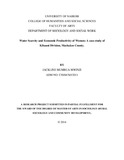| dc.description.abstract | Water is vital for life and a key catalyst to socio-economic development as well as maintenance
of environmental integrity in any region. It is an essential resource for sustaining life as well as
central to agriculture and rural development and affects the livelihoods of millions of rural
people across the world. Water scarcity is an issue that affects the economy negatively. It affects
one in three people on every continent of the globe. The situation is getting worse as needs for
water rise along with population growth, urbanization and increases in household and industrial
uses. It is among the main problems being faced by many societies and the World in the 21st
century. Water scarcity affects all people in the society but women bear the burden most as they
are traditionally regarded as the water collectors and majority of them rely on water for their
livelihoods.
The purpose of this research study was to find out the impact of water scarcity on the economic
productivity of women in Kibauni Division of Machakos County, with a view to answering three
research questions namely: What is the water and livelihood situation in Kibauni? How does
water scarcity affect economic productivity of women? And finally,What challenges are facing
water management and how are they addressed? The study size constituted of 360 respondents
selected using systematic random sampling. 2 focus group discussions and 10 key informants
were selected though purposive sampling technique. Both quantitative and qualitative data were
collected. The mechanism for the data collection involved both primary and secondary sources to
ensure triangulation and collection of reliable data. Data was collected using questionnaires,
observations, key informant guide, and Focus Group Discussion guide. Quantitative data was
analyzed using descriptive statistics through the use of SPSS. Qualitative data was edited, coded,
analyzed and interpreted to evaluate the usefulness of the information in answering the research
questions.
From the study findings, it was found out that water is a commodity that is vital for development
and almost all economic activities undertaken by women in the study area needed water as a
catalyst for their products. The study concluded that water scarcity and economic productivity of
women are intertwined and almost impossible to separate them. Water scarcity translates to poor
access to education, health problems, and increased work load as well as time wastage in search
of the rare, basic commodity.
It was also concluded that water scarcity is accelerated by population pressure, land use
changes, poor water harvesting methods, sand/gravel harvesting as well as poor agricultural
methods. The study recommended that the ministry of agriculture, water irrigation board as well
as the donor agencies need to invest in the community to exploit the underground water sources
to supplement the available water as this can reduce the problems that women as well as the girls
are facing while accessing water. Further, the study concluded that women should equally
participate with men in the water management projects and their decisions should be prioritized
since they are the major water collectors and managers at the household level and determine
how, where and when to collect the water. To achieve this, the study recommended that family
and societal support, access to education, access to resources and entrepreneurship training
should be enhanced to foster gender equality and economic empowerment of women | en_US |

